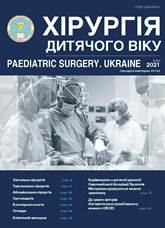Drug correction of the structural and functional state of bone tissue in patients with fibrous dysplasia
DOI:
https://doi.org/10.15574/PS.2021.71.42Keywords:
fibrous dysplasia, pathological fractures, bone deformities, drug therapy, bisphosphonates, pamidronic acid preparationsAbstract
In a significant number of patients with fibrous dysplasia, among various orthopedic pathologies, bone pain, its deformation and pathological fractures, disorders of bone tissue and its metabolism are leading. Issues of correction of clinical and orthopedic manifestations of the disease and changes in the structural and functional state of bone tissue are insufficiently studied and need improvement.
Purpose – to improve drug antiosteoporotic therapy for patients with fibrous dysplasia in order to reduce their pain, improve the condition of bone tissue and its metabolism.
Materials and methods. In the department of pediatric traumatology and orthopedics of the SI «ITO NAMSU» in the period from 2015 to 2020, 16 patients with FD were treated (with polyosal form – 6 patients, with Albright syndrome – 5, with Campanacci syndrome – 5), who have been used drug antiosteoporotic therapy, in particular with the use of antiresorbents (pamidronic acid preparations). The age of patients ranged from 6 to 28 years, 13 patients were children. Qualitative and quantitative assessment of the therapy results and reduction of pain was performed by applying the «VAS» scale, improving the condition of bone tissue and its metabolism by studying the mineral density of bone tissue and markers of bone metabolism.
Results. The article presents the rationale, general principles and features of antiosteoporotic therapy; indications and contraindications to it; calculations of doses and schemes of application of these or those drugs, including from group of bisphosphonates at a fibrous dysplasia. The presented drug therapy has been successfully tested in 16 patients with fibrous dysplasia. The effectiveness of the treatment is confirmed by the reduction or elimination of pain, stopping the progression of pathological bone disease of the lower limbs, improving structural condition of bone tissue and its metabolism.
Conclusions. The results of drug therapy in patients with fibrous dysplasia indicates its effectiveness and appropriateness of use, which is shown by the relief of pain, improving the structural condition of bone tissue and its metabolism.
References
Chapurlat RD, Delmas PD, Liens D, Meunier PJ. (1997). Long-term effects of intravenous pamidronate in fibrous dysplasia of bone. J Bone Miner Res. 12: 1746-1752. https://doi.org/10.1359/jbmr.1997.12.10.1746; PMid:9333137
Chapurlat RD, Gensburger D, Jimenez-Andrade JM, Ghilardi JR, Kelly M, Mantyh P. (2012). Pathophysiology and medical treatment of painin fibrous dysplasia of bone Orphanet Journal of Rare Diseases. 7 (1): S3. https://doi.org/10.1186/1750-1172-7-S1-S3; PMid:22640953 PMCid:PMC3359957
Corsi A, Ippolito E, Robey PG, Riminucci M, Boyde A. (2017, Oct). Bisphosphonate-induced zebra lines in fibrous dysplasia of bone: histo-radiographic correlation in a case of McCune Albright-Syndrome. Skeletal Radiol. 46 (10): 1435-1439. https://doi.org/10.1007/s00256-017-2698-2; PMid:28660402 PMCid:PMC5709201
Crofton PM, Evans N, Taylor MRH, Holland CV. (2002). Serum Cross Laps: pediatric reference intervals from birth to 19 years of age. Clin Chemistry. 48 (4): 671-673. https://doi.org/10.1093/clinchem/48.4.671; PMid:11901074
Crofton PM, Evans N, Taylor MRH, Holland CV. (2004). Procollagen Type I amino-terminal propeptide: pediatric reference data and relations hip with procollagen type I carboxy l-terminal propeptide. Clin. Chemistry. 50 (11): 2173-2176. https://doi.org/10.1373/clinchem.2004.039958; PMid:15502092
Javaid MK, Boyce A, Appelman-Dijkstra N, Ong J et al. (2019). Best practice management guidelines forfibrous dysplasia/Mc-Cune-Albright syndrome: a consensus statement from the FD/MAS international consortium. Orphanet Journal of Rare Diseases. 14: 139. https://doi.org/10.1186/s13023-019-1102-9; PMid:31196103 PMCid:PMC6567644
Lala R, Matarazzo P, Bertelloni S, Buzi F, Rigon F, de Sanctis C. (2000). Pamidronate treatment of bone fibrous dysplasia in nine children with Mc Cune Albright syndrome. Acta Paediatr. 89: 188-193. https://doi.org/10.1111/j.1651-2227.2000.tb01214.x; PMid:10709889
Meier ME, van der Bruggen W, van de Sande MAJ, Appelman-Dijkstra NM. (2021, Apr 9). Regression of fibrous dysplasia in response to denosumab therapy: A report of two cases Bone Reports. 14: 101058. https://doi.org/10.1016/j.bonr.2021.101058; PMid:33912627 PMCid:PMC8066421
Pfeilschifter J, Ziegler R. (1998). Effect of pamidronate on clinical symptoms and bone metabolism in fibrous dysplasia and Mc-Cune-Albright syndrome. Med Klin. 93: 352-359. https://doi.org/10.1007/BF03044679; PMid:9662942
Plotkin H, Rauch F, Zeitlin L, Munns C, Travers R, Glorieux FH. (2003). Effect of Pamidronate Treatment in Children with Polyostotic Fibrous Dysplasia of Bone. J Clin Endocr&Metabol. 88: 4569-4575. https://doi.org/10.1210/jc.2003-030050; PMid:14557424
Tripathy SK, Swaroop S, Velagada S, Priyadarshini D et al. (2020, Nov). Response to Zoledronic Acid Infusion in Children With Fibrous Dysplasia. Frontiers in Pediatrics. 8: Article 582316. https://doi.org/10.3389/fped.2020.582316; PMid:33330278 PMCid:PMC7732464
Zacharin M, O'Sullivan M. (2000). Intravenous pamidronate treatment of polyostotic fibrous dysplasia associated with the McCune-Albright syndrome. J Pediatr. 137: 403-409. https://doi.org/10.1067/mpd.2000.107836; PMid:10969268
Downloads
Published
Issue
Section
License
The policy of the Journal “PAEDIATRIC SURGERY. UKRAINE” is compatible with the vast majority of funders' of open access and self-archiving policies. The journal provides immediate open access route being convinced that everyone – not only scientists - can benefit from research results, and publishes articles exclusively under open access distribution, with a Creative Commons Attribution-Noncommercial 4.0 international license(СС BY-NC).
Authors transfer the copyright to the Journal “PAEDIATRIC SURGERY.UKRAINE” when the manuscript is accepted for publication. Authors declare that this manuscript has not been published nor is under simultaneous consideration for publication elsewhere. After publication, the articles become freely available on-line to the public.
Readers have the right to use, distribute, and reproduce articles in any medium, provided the articles and the journal are properly cited.
The use of published materials for commercial purposes is strongly prohibited.

